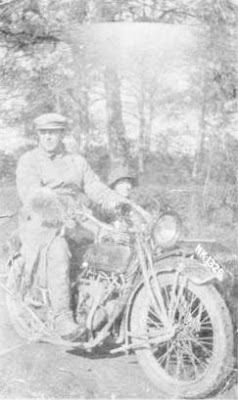We now move westwards from the Senior Central School (Fleetville Juniors today) on the third field to be sold by the Grammar School, but rather later than the fields incorporating the Fleet Works and Fleet Ville. Called Poor Six Acre Field we assume the name to reflect the quality of its top soil. [Further along the road at the cemetery this top and sub-soil is brought to the surface when new burials are due]. So selling for development would have been an easy decision to make. During and following the First World War the field, or at least a part of it, was delineated into allotment plots "for the war effort", partly to avoid the recreation ground being utilised for the same purpose, which was certainly a real risk.
To fully understand which plots today occupy the front of this field, the first to the west of the school's vehicular entrance is Grimsdyke Lodge, then BC Cycles and Magnet. Although Topps Tiles is also part of the modern range of development this will form part of the next post.
The Valuation Office records from 1910 to 1915 reveal that during the lifetime of its data, W H Lavers, the owner of the timber yard nearby, also acquired the frontage land to the west of the school entrance, 206 to 202 and possibly 208 as well. So, we will consider number 208 first. It is doubtful if many current residents of the district recall a detached house to the west of the school entrance, but a photograph in the St Albans' Museums Archive shows one to be there.
It was erected shortly after the First World War and its first occupant was Mrs Bell; her name appears as the occupant in the 1930 and 1934 street directories. From then on the occupant was Mrs Wilkins. In both cases we only know their names. If Mrs Bell was the owner of the house she may also have purchased the adjacent land, the plots taken over by Mr Lavers from the Grammar School. From then on numbers 208 to 202 were treated as a single plot of ground even though no further houses were built there. However, a row of lock-up garages existed at the back of 206 to 202 from c1930 until 1967.An article in the Herts Advertiser 19th April 1973 revealed that Mrs Wilkins had planted an oak seed on her land in 1935 to celebrate the Silver Jubilee of George V and Queen Mary. She very much wanted to protect the tree from development by Fairview Estates to whom she had sold her property in 1967. Your Editor cannot recall such a tree being present, although a photograph from the archives of St Albans Museums proves it was growing in the front garden. The oak tree – which would now be 86 years old – is not within the boundary of Grimsdyke Lodge today.
 |
| The left section of Grimsdyke Lodge was the location of the former detached house. |
Grimsdyke Lodge, a development of eight 1-bed flats, dates from 1967 and a central throughway gives access to rear parking. It is thought that the name of the building came from Grimsdyke Developments, a development arm of Fairview Estates.
Numbers 200, 198 and 196 were created in 1910 by builder James Andrew, who also occupied the western end of this multi plot. He also had a shop on the north side of the road directly opposite from which he sold building accessories and fittings. Mr Andrew constructed a two-bay unit consisting of shops on the ground floor with living accommodation above – often the upper floors were converted into storage areas, but it is not certain whether that was the case here. Two ground-floor-only shop units were added later, one on each side of the original structure, and this part of Hatfield Road became a very successful DIY centre managed by Leonard Reed – until the industrial estate DIY warehouses popular from the 1980s motoring boom, and suddenly Reed's became no more. |
| The fullest four-section extent of Leon Reed's DIY Centre shortly after its closure. COURTESY DIANA DEVEREUX |
Leonard Reed took over in the mid-1950s and gradually expanded into the ladies' outfitter unit and then built first one wing on the eastern side, followed by a second on the western side, on the land previously occupied by James Andrew's open depot for his building trade, although that must have gone by the time I first knew Fleetville in the 1950s.
200 and 198 were demolished and replaced by the modern Richmond House, home to Weddings Unlimited and now BC Cycles. It is a mixed site incorporating retail and apartments.
This part of Hatfield Road has seen plenty of variety in its urbanisation since it was a field with poor soil, with many changes too. And Mrs Wilkins' oak tree was only one of the oaks failing to survive to the modern day. Seven mature oak trees quietly growing in the field were felled and offered for sale, possibly to make sale for development much easier.
Next time we will be introduced to a member of a very well-known family.
















